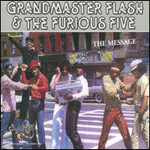|
|
 |
Dusted Reviews
Artist: Grand Master Flash Album: The Message / They Said It Couldn't Be Done Label: DBK Works Review date: Jun. 6, 2005 |

|
|
|
 |
The tipping point for hip-hop as a valid form of pop expression was, without a doubt, Grandmaster Flash and the Furious Five's platinum 1982 single, "The Message." No getting around that – seven minutes of ghetto reality set to an unforgettable synth hook and framed by a steady beat that, coupled with the harsh lyrics, brought dance floors down to a head nod and made listeners focus on the group's tales of the street. That's all it took to push the growing popularity of rap music and culture over to the attention of outlets ranging from the fledgling MTV to top 40 radio to Newsweek. The Five's delivery didn't point fingers, at least not directly – Melle Mel, Cowboy, Scorpio, Kid Creole and Raheim laid their words down on the line, without preaching. It's a sterling moment in pop history, chronicling the problems of racial profiling, poverty, drug addiction, welfare, crime, and the perpetual cycle of chaos and despair that these conditions generate. It's also the kind of moment that artists only get one shot at nailing down, and given the bleakness (and length) of the track, and its indie-label release on Sugar Hill, it's a small miracle that Flash pulled it off and kicked the doors open for the music industry to view rap music as commercially viable. (And oddly enough, it would prove to be the bone of contention which would disband the Furious Five; more on that later).
"The Message" lives at the end of an album of the same name – the group's debut long-player – released in 1982 on Sugar Hill and reissued here in a no-frills package by DBK Works. The album itself is no more than a collection of three singles and a few album cuts, but it works for what it needs to, when it needs to. With that, the B-side's only saving grace is "The Message"; the less said about the two Quiet Storm-style numbers that precede it, the better. But up front, things are much nicer. Opener "She's Nasty" takes an obscure funk/soul burner (1974's "The Lovemaniacs" by Boobie Knight and the Universal Lady) and coats it with new technology and an energetic performance, as fairly complex stabs of synth and horn burst all around high-energy rap performances, rapid-fire percussion and the incredibly tight bass playing of Doug Wimbish. The hits just keep on coming with "It's Nasty" (lifting the melody from Tom Tom Club's hit "Genius of Love") and the blazing electro monster "Scorpio," where synthesized vocals, early sampling technology, and acid-fried bass squiggles square off in a winner-takes-all battle for control of the arpeggio knob. The side closes with another cover, this time combining the Spinners' "It's a Shame" guitar riff with the meat of Pieces of a Dream's "Mt. Airy Groove," beneath group vocals calling for unity in the community.
This piecemeal gathering of rap music's founding sounds – the sample – would soon become the biggest issue within the music, next to its lyrical content; the artists who provided the source or inspiration for the background music wanted their cut. Liquid Liquid sued Sugar Hill over the subsequent Grandmaster Flash & Melle Mel release, "White Lines," and while the group lost their court battle over the use of their track "Cavern" in that single, the costs of the case effectively put Sugar Hill out of commission. Questions of who was actually behind the Furious Five's music lingered as well, as the label pushed to separate Flash from the group he assembled and make Melle Mel its breakout star. Acrimoniously, Flash and Mel split, and Flash left the label for a solo career with Elektra on 1985's They Said It Couldn't Be Done, backed by only two members of the original Furious Five and three members of the new crew. As its title suggests, the album sets out to prove that Flash could run the show on his own, and while most of the tracks never hit the highs of the group's previous singles, the album is much more evenly ordered, and is listenable the whole way through. Somewhat tired attempts at genre crossover, namely the Cotton Club zoot suit styles of "The Joint is Jumpin'" and the heavy metal guitars of "Rock the House," seem to take precedent over the album's greatest strengths, namely the B-side openers "Sign of the Times" and "Larry's Dance Theme." The former is one of the group's strongest offerings, trying to recapture the prescience of "The Message" with yet another message, and ending up with a chilly, danceable track built around a proto-downtempo synth lead. The latter is a robotic breakdance anthem in league with the Art of Noise, with plenty of tape manipulation and cut 'n' scratch sample sourcing and wordplay. If the rest of the album runs a bit long, it's not for the sake of these anchor tracks, some of the last salvos of the old school as the sounds and business behind hip-hop accelerated into mass acceptance.
By Doug Mosurock
|







